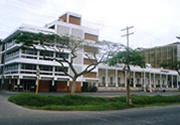 The Bank of Guyana was established by virtue of the Bank of Guyana Ordinance No. 23 of 1965. Actual operation commenced on October 16. 1965 – seven months before the country gained political independence. The early establishment of the Bank was promoted by an agreement of the U.K. Government (acting for the still colonial members of the British Caribbean Currency Board (BCCB) and the Trinidad & Tobago Government), for the dissolution of the BCCB by mid-1967 and the cessation of issuance of currency after 1965.
The Bank of Guyana was established by virtue of the Bank of Guyana Ordinance No. 23 of 1965. Actual operation commenced on October 16. 1965 – seven months before the country gained political independence. The early establishment of the Bank was promoted by an agreement of the U.K. Government (acting for the still colonial members of the British Caribbean Currency Board (BCCB) and the Trinidad & Tobago Government), for the dissolution of the BCCB by mid-1967 and the cessation of issuance of currency after 1965.
The Bank of Guyana Ordinance established the Central Bank as an ‘autonomous institution' with headquarters in the capital city of Georgetown with the following principal objectives:
with the following principal objectives:
Within the context of the economic policy of the Government, the Bank shall be guided in all its actions by the objectives of fostering monetary stability and promoting credit and exchange conditions conducive to the growth of the economy of Guyana.
Apart from specifying the administrative and management arrangements for the Bank, the Ordinance, inter alia, decreed the Bank to:
- have the sole right to issue and redeem notes and coins
- act as banker to the commercial banks
- act as fiscal agent and trustee of and banker to the Government
- administer payment agreements entered into by the Government
At its establishment, the Bank was housed in temporary premises in three locations. The Governor operated from an office assigned to him in the Parliament Building.
Office space was rented from the Colonial Life Insurance Company, High Street, Georgetown, to house the Research Department while the BCCB's office in the General Post Office Building, Georgetown, executed currency operations on behalf of the Bank.
The Bank commenced operations under the leadership of its first Governor, Dr. Horst Bockelman, who was seconded from the Bundesbank, Germany. A reputable banker with considerable experience, he had the advantage of being involved in setting up the Central Bank in neighbouring Trinidad and Tobago.
The Governor was later supported by Mr. Kemal Sogancilar, who was appointed Banking Manager.
He was seconded from the Central Bank of Cyprus but served earlier in the Turkish Central Bank.
All of the other positions were initially held by Guyanese. Two years later, Mr. William P. D’Andrade acceeded to the top position to become the first Guyanese Governor of the Bank. He was no stranger to the workings of the Bank since he was an ex-officio member of the Board of Directors as a result of his substantive post of Secretary to the Treasury, Ministry of Finance and later served briefly as Deputy Governor.
The Bank commenced issuing the new national currency notes on November 15, 1965, to replace the BCCB notes, the issuance of which was expected to cease by December 31, 1965. However, national coins were not issued until the mid 1967. To date, the Bank has maintained De La Rue and the Royal Mint as suppliers of the nation's currency.
The Ordinance establishing the Bank was revised and became the Bank of Guyana Act. CAP:85:02. This Act was further revised in 1995, 1998 and latterly in 2004. The later revisions significantly enhanced the role and purpose of the Bank within the framework of Guyana’s economic and financial system. Additionally, they imparted greater autonomy to the Bank in terms of its constitution, administration and operations.
Since its establishment, the Bank has unassumingly laid the foundation for the economic growth of Guyana notwithstanding the many challenges. It has provided leadership to the financial system and the public sector in general, under often time difficult situations.
